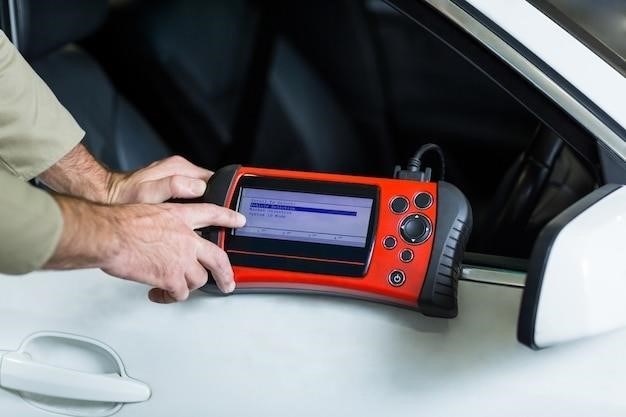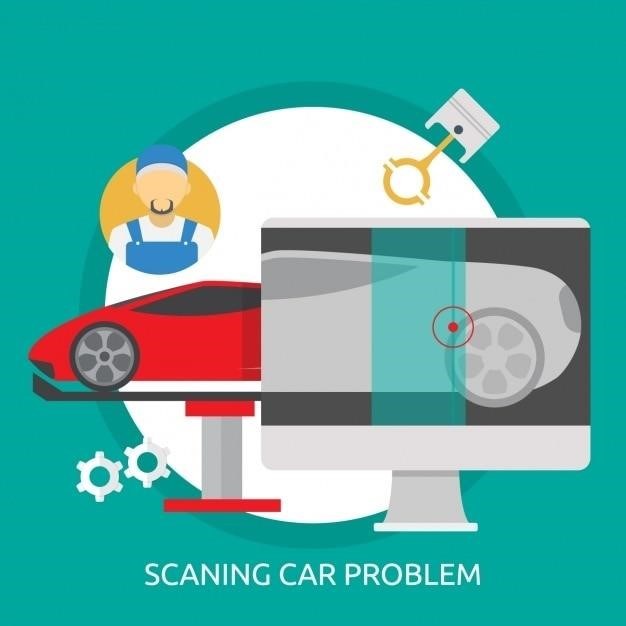
obd2 eobd scanner manual
OBD2/EOBD Scanner Manual⁚ A Comprehensive Guide
This manual provides a comprehensive guide to understanding and using OBD2/EOBD scanners, essential tools for diagnosing and troubleshooting vehicle issues. We will cover the basics of OBD2/EOBD technology, explore different types of scanners, and delve into the practical aspects of using them, including connecting, reading codes, monitoring live data, and interpreting common OBD2/EOBD codes. We will also discuss troubleshooting techniques, safety precautions, and common OBD2/EOBD related issues.
Introduction
The modern automobile is a complex machine, and like any complex machine, it can sometimes experience problems. In the past, diagnosing these problems could be a time-consuming and frustrating process. However, the development of On-Board Diagnostics (OBD) technology has revolutionized the way we troubleshoot and repair vehicles. OBD systems are built into modern cars to monitor various engine and vehicle systems, and they can detect and store information about any issues that arise.
OBD2/EOBD scanners are essential tools for accessing this information and providing insight into the health and performance of your vehicle. They allow you to read and interpret diagnostic trouble codes (DTCs), which are numerical codes stored by the vehicle’s computer system to indicate specific problems. By understanding these codes, you can pinpoint the source of an issue and take appropriate action to resolve it.
This manual serves as a comprehensive guide to help you understand and utilize OBD2/EOBD scanners effectively. Whether you are a seasoned mechanic or a car enthusiast, this guide will equip you with the knowledge and skills to diagnose and troubleshoot vehicle issues with confidence.
What is an OBD2/EOBD Scanner?
An OBD2/EOBD scanner is a diagnostic tool that connects to your vehicle’s On-Board Diagnostics (OBD) system, allowing you to access and interpret information about the vehicle’s health and performance. This system is a standardized computer-based diagnostic system that has been mandatory in all gasoline-powered vehicles sold in the United States since 1996. In Europe, the equivalent standard is known as EOBD (European On-Board Diagnostics).
OBD2/EOBD scanners come in various forms, from handheld devices to smartphone apps. They are designed to communicate with the vehicle’s onboard computer, known as the Powertrain Control Module (PCM), which continuously monitors various engine and vehicle systems. The PCM stores diagnostic trouble codes (DTCs) whenever it detects a problem, and an OBD2/EOBD scanner can read and interpret these codes to provide valuable information about the issue.
In addition to reading DTCs, OBD2/EOBD scanners can also display live data from various sensors and systems within the vehicle, such as engine speed, coolant temperature, and fuel pressure. This live data can be invaluable for troubleshooting performance issues or monitoring the health of specific components.
Types of OBD2/EOBD Scanners
OBD2/EOBD scanners come in a variety of forms, each with its own set of capabilities and features. The most common types include⁚
- Handheld Scanners⁚ These are compact and portable devices with a built-in screen and a cable that plugs into the vehicle’s OBD port. They are typically more affordable and suitable for basic diagnostics, such as reading and clearing trouble codes.
- Wireless Scanners⁚ Wireless scanners connect to your smartphone or tablet via Bluetooth or Wi-Fi. They offer the advantage of portability and can be used with a dedicated app for more advanced diagnostics.
- Professional-Grade Scanners⁚ These are more expensive and feature-rich devices often used by mechanics. They offer advanced functionalities like live data streaming, bi-directional controls, and access to manufacturer-specific codes.
The type of scanner you choose depends on your needs and budget. For casual users, a basic handheld scanner might be sufficient. For more advanced diagnostics or professional use, a wireless or professional-grade scanner would be more appropriate.
Using an OBD2/EOBD Scanner
Using an OBD2/EOBD scanner is a straightforward process, but it’s essential to follow the instructions carefully to ensure accurate results. Here’s a general overview of the steps involved⁚
- Locate the OBD Port⁚ The OBD2 port is typically located under the dashboard, near the steering column. It’s a 16-pin rectangular connector.
- Connect the Scanner⁚ Plug the scanner’s cable into the OBD port. For wireless scanners, ensure Bluetooth or Wi-Fi connectivity with your device.
- Turn on the Ignition⁚ Switch the ignition to the “ON” position, but do not start the engine.
- Follow Scanner Instructions⁚ Each scanner may have slightly different instructions. Refer to the user manual for specific guidance on navigating the menus and performing diagnostics.
Once connected, you can access various diagnostic functions, such as reading trouble codes, viewing live data, and clearing codes. The specific features available depend on the scanner’s capabilities.
Connecting the Scanner
Connecting your OBD2/EOBD scanner to your vehicle’s diagnostic port is a crucial step in the diagnostic process. Before you begin, ensure the ignition is off and the vehicle is parked in a safe location. Here’s a step-by-step guide to connecting the scanner⁚
- Locate the OBD Port⁚ The OBD2 port is typically located under the dashboard, near the steering column. It’s a 16-pin rectangular connector. Look for a label that says “OBD II” or “EOBD.”
- Prepare the Scanner⁚ Ensure your scanner is powered on and ready for use. If using a wireless scanner, establish a Bluetooth or Wi-Fi connection to your smartphone or tablet.
- Connect the Cable⁚ Plug the scanner’s cable into the OBD port. Secure the connection to prevent accidental disconnection.
- Turn on the Ignition⁚ Turn the ignition to the “ON” position but do not start the engine. This allows the vehicle’s computer system to communicate with the scanner.
Once the scanner is connected, you should see a confirmation message or a prompt on the scanner’s display. The scanner is now ready to perform diagnostics and retrieve data from your vehicle’s systems.

Reading and Interpreting Codes
Once connected, your OBD2/EOBD scanner can retrieve diagnostic trouble codes (DTCs) stored in your vehicle’s computer system. These codes provide valuable insights into potential issues affecting your vehicle’s performance. Here’s how to read and interpret codes⁚
- Initiate Code Retrieval⁚ Select the “Read Codes” or “Diagnostic Codes” option on your scanner’s menu; The scanner will communicate with your vehicle’s computer and retrieve any stored codes.
- Code Display⁚ The scanner will display the codes in a standard format, typically consisting of a letter (P, B, C, or U) followed by four digits.
- Code Interpretation⁚ Use a code lookup guide, a repair manual, or an online resource to decipher the meaning of each code. These resources provide detailed explanations of the code’s definition and potential causes.
- Code Clearing⁚ Once you have identified and addressed the issue, you can clear the codes from the vehicle’s memory using the scanner’s “Clear Codes” or “Erase Codes” option.
Understanding and interpreting DTCs empowers you to diagnose problems efficiently and make informed repair decisions. By utilizing the scanner’s capabilities and referencing appropriate resources, you can effectively troubleshoot vehicle issues.
Live Data Monitoring
Beyond retrieving diagnostic codes, OBD2/EOBD scanners offer real-time monitoring of your vehicle’s sensors and systems. Live data monitoring allows you to observe various parameters in action, providing valuable insights into your vehicle’s performance and potential issues. Here’s how live data monitoring works⁚
- Accessing Live Data⁚ Select the “Live Data” or “Data Stream” option on your scanner’s menu. The scanner will connect to your vehicle’s computer and display a list of available data parameters.
- Parameter Selection⁚ Choose the specific parameters you want to monitor, such as engine RPM, coolant temperature, fuel pressure, or oxygen sensor readings.
- Data Visualization⁚ The scanner will display the selected data parameters in real-time, often in numerical or graphical formats.
- Analyzing Trends⁚ Observe the data values over time to identify patterns or anomalies that may indicate potential problems. This can help you diagnose issues that may not trigger a check engine light.

Live data monitoring is a powerful tool for preventative maintenance and troubleshooting. It allows you to monitor your vehicle’s health in real-time, identify potential issues early, and gain a deeper understanding of your vehicle’s performance.
Common OBD2/EOBD Codes
OBD2/EOBD codes are standardized alphanumeric codes used to identify specific problems within your vehicle’s systems. These codes are stored in your car’s computer (ECU) and can be retrieved using an OBD2/EOBD scanner. Understanding these codes is crucial for diagnosing and resolving vehicle issues. Here’s a breakdown of the common code categories⁚
- Powertrain (P) Codes⁚ These codes relate to the engine and transmission systems, covering issues like misfires, fuel system problems, catalytic converter malfunctions, and sensor failures.
- Body (B) Codes⁚ These codes address issues related to body electronics, including problems with the lighting system, door locks, windows, and other comfort features.
- Chassis (C) Codes⁚ These codes cover the vehicle’s chassis and suspension systems, including issues with the ABS, traction control, and stability control systems.
- Network and Wiring (U) Codes⁚ These codes indicate problems with the communication network between the vehicle’s various control modules or with the wiring itself.
Each code is a unique combination of letters and numbers, providing specific information about the detected problem. By understanding these codes, you can pinpoint the root cause of the issue and take appropriate action to resolve it.
Powertrain (P) Codes
Powertrain (P) codes are the most common type of OBD2/EOBD codes, indicating issues within the engine and transmission systems. These codes are essential for diagnosing a wide range of problems, from simple misfires to complex engine management issues. Here’s a glimpse into some common Powertrain codes and their potential causes⁚
- P0300 ⎻ P030X⁚ These codes indicate a misfire in one or more cylinders. Causes can range from faulty spark plugs or ignition coils to problems with fuel injectors or even a failing oxygen sensor.
- P0171 ⎻ P0175⁚ These codes point to a lean or rich fuel condition, meaning the engine is receiving too much or too little fuel. Possible causes include issues with the fuel injectors, fuel pressure regulator, or air intake system.
- P0420 ⎼ P0430⁚ These codes signal a malfunctioning catalytic converter, which is responsible for reducing harmful emissions. This could be due to a failing catalytic converter itself, a problem with the oxygen sensors, or even an issue with the fuel system.
- P011X⁚ These codes indicate problems with the intake air temperature sensor, which measures the temperature of the air entering the engine. A faulty sensor can lead to inaccurate fuel mixture calculations and other engine performance issues.
By understanding the specific code and its potential causes, you can take the necessary steps to diagnose and resolve the underlying issue.
Body (B) Codes
Body (B) codes, unlike powertrain codes, focus on the vehicle’s comfort and convenience features. These codes relate to various components like lighting, climate control, door locks, and more. While these codes might not directly impact the engine’s operation, they can significantly affect the driver and passenger experience. Here are some common Body codes and their potential causes⁚
- B1xxx⁚ These codes often indicate issues with the body control module (BCM), which manages various body functions. A faulty BCM can lead to problems with door locks, windows, lights, or even the instrument cluster.
- B2xxx⁚ Codes within this range usually point to issues with the vehicle’s lighting system; This could include problems with the headlights, taillights, turn signals, or even interior lights.
- B3xxx⁚ These codes often relate to the vehicle’s climate control system. Faulty sensors, actuators, or even a malfunctioning climate control module can trigger these codes.
- B4xxx⁚ This range of codes typically deals with the vehicle’s electrical system, covering issues with wiring, fuses, and other electrical components.
By understanding the specific Body code, you can pinpoint the source of the problem and take appropriate steps to resolve it, ensuring a comfortable and safe driving experience.
Comments (0)